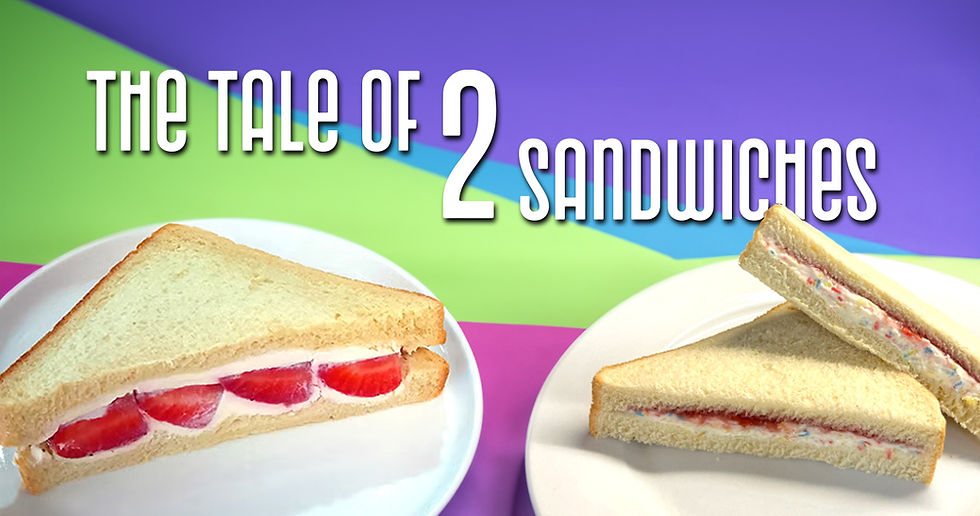The Sweet Spot of Snacking: A Tale of Two Sandwiches
- Rhys Bennett
- Aug 14
- 4 min read

The UK's food and beverage market is a constant battleground for innovation, and nothing exemplifies this better than the recent sweet sandwich saga. In a world hungry for the next big thing, the humble lunchtime staple was thrust into the spotlight, leading to one viral hit and one notable misstep. The story of Marks & Spencer’s strawberry and cream sandwich and Tesco’s birthday cake sandwich is more than just a tale of two products; it’s a masterclass in the fine, and often perilous, art of NPD innovation.
The Anatomy of a Hit: The M&S Strawberry and Cream Sensation
The success of the M&S strawberry and cream sandwich was a perfect storm of timing, inspiration, and flawless execution. It was a well-executed nod to the Japanese furutsu sando, a popular fruit sandwich, and a clever tie-in to the quintessentially British tradition of Wimbledon. The product hit the sweet spot of "permissible novelty". It was new and different enough to generate buzz, but its foundation was built on comfortingly familiar, high-quality ingredients: fresh strawberries, rich cream, and soft, white bread.
The sandwich wasn't just an idea—it was a genuinely delicious product. This combination of novelty with a deep respect for quality resonated deeply with consumers, turning it into a social media sensation. People didn't just buy it to take a photo; they bought it because they genuinely wanted to eat it. In a market where gimmicks often fall flat, M&S proved that combining a great concept with a great product is a winning formula.
The Misstep: The Tesco Birthday Cake Miscalculation
In contrast, Tesco's birthday cake sandwich, while a clever and timely response to the trend, could be considered as a misstep in execution. The product, featuring layers of jam, cream cheese icing, and sprinkles, was an attempt to push the sweet sandwich concept even further. However, the feedback was a sobering lesson in the risks of crossing the line from "new and exciting" to "novel but strange".
Consumer reviews were highly mixed, with many finding the combination to be sickly sweet and the texture unappealing. Where the M&S sandwich was grounded in fresh, simple ingredients, the birthday cake version felt like a product of pure novelty. It demonstrated the danger of focusing on a gimmick without a deep understanding of consumer palates and a commitment to genuine taste. The product lacked the foundation of familiarity and quality that made its predecessor a success, and in doing so, it became a cautionary tale in modern NPD.
The Golden Rule of Innovation: Where to Draw the Line
The lesson from the sandwich renaissance is clear: innovation is not about being different; it's about being different with a purpose. For NPD professionals, this means a deep understanding of the delicate balance between what is new and what is genuinely desirable. The most successful innovations are a blend of the familiar and the fresh, offering a new experience without alienating the consumer.
The key is to ask a few vital questions:
Is this a gimmick or a genuine innovation?
Does this product deliver on taste and quality, or just on surprise?
Does it respect the core identity of the product, or does it push the concept too far?
In a market hungry for newness, the real skill is knowing where to draw that line.
What's Next? UK Brands Reinventing Classic Foods
The sandwich saga proves that even the most established food products are ripe for innovation. By applying the lessons learned from the sweet sandwich debacle—balancing novelty with quality and consumer understanding—UK food companies are successfully reinventing other classic foods.
Pies & Sausage Rolls: Brands are moving beyond traditional fillings. Higgidy, for instance, has built a brand on putting a fresh, premium spin on pies, quiches, and sausage rolls with adventurous, chef-inspired fillings. They use high-quality, recognisable ingredients to elevate everyday comfort food. Ginsters, well-known for pasties for their, has also expanded its NPD to include vegan and gluten-free options, catering to a wider audience while staying true to its core savoury pastry format.
Desserts: The classic British trifle, for example, is often seen as old-fashioned. Companies like Bakkavor, the leading supplier of chilled desserts, have revitalised classic formats by introducing new flavour combinations. In the past, they've launched éclairs with distinctly British flavours like 'Strawberries and Cream' and 'Sticky Toffee', modernising a French classic with a nostalgic UK twist.
Breakfast & Bakery: The traditional malt loaf has found new life. Soreen, the long-standing bakery brand, has innovated beyond its classic loaf by introducing smaller, pre-portioned lift bars' and flavour variants like raspberry and vanilla. This brings a traditional product into the modern, convenient snacking space, appealing to both families and busy professionals.
The lesson for NPD professionals is clear: these successful companies aren't just creating new products; they're reimagining old favourites for a new generation. By focusing on premium ingredients, catering to dietary needs, and rethinking convenience, they’re ensuring that classic British foods remain relevant and exciting in an ever-changing market.



